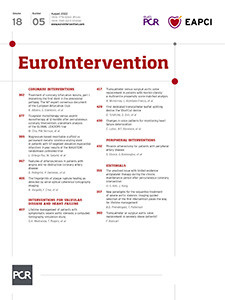Over the past 20 years, interventional cardiologists have tried to give an answer to a very simple question, “What is the optimal antiplatelet regimen after percutaneous coronary intervention (PCI)?” More than 40 randomised clinical trials have been performed, but we still do not have a concrete conclusion. Currently, an individualised risk stratification and personalised medicine seem to be the answer. There has been a paradigm shift (or expansion) in the way that antiplatelet agents are prescribed in clinical practice. In the past, the targets of antiplatelet agents were local factors (stent-related), therefore finding a strategy that reduced PCI-related ischaemic events was the main issue. However nowadays, the axis has expanded to a systemic treatment domain, and the issue is now how to treat the patient as a whole by preventing any vascular complications and bleeding events1. The recent attention on specific populations (i.e., patients at high bleeding risk, patients who receive complex PCI), who were excluded from previous clinical trials, is also in line with this trend. Consequently, extending our focus to beyond the first year post-PCI is essential.
Most of the landmark clinical trials on antiplatelet agents in patients who undergo PCI focused their results on the first year after PCI. This is the most vulnerable period, during which patients may benefit from a stronger antiplatelet agent. After the first year, the patient is relatively stable in terms of stent-related events, whilst the role of antiplatelet agents is expanded to a “systemic treatment” strategy. The patient needs be protected from any adverse events; the ischaemic risk should be reduced, and the bleeding risk should also be controlled. However, few studies have elucidated the optimal antiplatelet regimen beyond the first year post-PCI. Previously, the Dual Antiplatelet Therapy (DAPT) study compared DAPT with aspirin monotherapy beyond 1 year after PCI in 9,961 patients. During the 18-month follow-up period, patients on DAPT showed a significant reduction in stent thrombosis and major adverse cardiovascular and cerebrovascular events compared with those on aspirin monotherapy, at the cost of an increased risk of bleeding2. Recently, the HOST-EXAM trial compared clopidogrel monotherapy with aspirin monotherapy beyond 1 year after PCI in 5,438 patients and reported that the primary event rate was lower in the clopidogrel monotherapy group, which was driven by a reduction in both thrombotic and bleeding events3.
The current study by Ono et al, in this issue of EuroIntervention, is also covering this ground and reports a subgroup analysis of the GLOBAL LEADERS trial. A total of 11,121 patients (ticagrelor monotherapy: n=5,308; aspirin monotherapy: n=5,813) who were free from any clinical events at 1 year post-PCI and those who had adhered to the prescribed antiplatelet regimen were analysed. During the second year after PCI, the ischaemic composite endpoint was lowered by 26% with ticagrelor monotherapy compared to aspirin monotherapy. Conversely Bleeding Academic Research Consortium (BARC) type 3 or 5 bleeding was increased by ticagrelor monotherapy, although with marginal significance. The authors should be congratulated because this study has added valuable information for comparing ticagrelor and aspirin monotherapy during the chronic maintenance period after PCI. However, a few important aspects should be noted to interpret the study results.
First, it should be noted that the patient population of this study was a low-risk population with stable coronary artery disease. Only 70% of the patients from the original GLOBAL LEADERS trial were included in this analysis, after excluding those who had experienced adverse events within the first year post-PCI. Therefore, the ischaemic event rates were low, reflecting stable patients in the chronic maintenance period. Although the ischaemic composite endpoint was decreased by ticagrelor monotherapy, the impact on net adverse clinical events was neutral between the 2 groups, due to the increased bleeding events in the ticagrelor monotherapy group. Along with the large number needed to treat to prevent an adverse event by ticagrelor monotherapy, the benefit over aspirin monotherapy does not seem to be concrete. Second, the authors refer to the HOST-EXAM trial, which exclusively enrolled Asian patients, and state that the ethnic differences in the risk of ischaemic and bleeding events should be considered to interpret the different results between the 2 trials. The risk reduction in a patient population with higher ischaemic risk (which the authors cite as the “Western population”) should be greater with a potent P2Y12 inhibitor. As the HOST-EXAM trial showed a larger risk reduction with clopidogrel monotherapy than with the ticagrelor in the current study, the distinct results between the 2 studies cannot be explained by ethnic differences. Alternatively, clopidogrel may be strong enough to reduce ischaemic events in Asians who have low thrombogenicity, while ticagrelor may not be sufficient to further reduce ischaemic events in Caucasians with high thrombogenicity. Third, a previously published subgroup analysis of the GLOBAL LEADERS trial should be highlighted in association with this analysis. Serruys et al assessed the impact of complex PCI from the original GLOBAL LEADERS trial. At 2-year follow-up, the ticagrelor-based treatment significantly reduced the risk of the ischaemic endpoint, while this benefit was not seen in patients undergoing non-complex PCI (p for interaction=0.015)4. However, in the current analysis, there was no difference in ticagrelor versus aspirin monotherapy according to the complexity of PCI. This denotes that the benefit of ischaemic event reduction by a potent P2Y12 inhibitor was mostly driven by event reduction within the first year after PCI.
Collectively, the current study reflects a paradigm shift in the prescription of antiplatelet agents, warranting further investigation during the chronic maintenance period after PCI. Adding evidence via clinical trials is essential, while not only antiplatelets but also anticoagulants seem to have a role during this period. Finding the sweet spot for balancing ischaemic and bleeding risk seems to be more important during the chronic maintenance period.
Conflict of interest statement
The authors have no conflicts of interest to declare.
Supplementary data
To read the full content of this article, please download the PDF.

